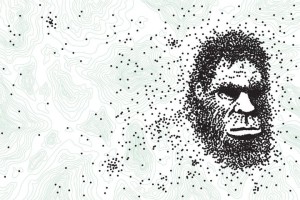The Secret Lives of Bigfoot Hunters
Posted by: Craig Woolheater on April 12th, 2016

A scientist turned reality TV star and a true believer turned analyst are both on a quest for one of the Northwest’s most elusive mysteries.
Lit only by moonlight in the Tennessee woods, Ranae Holland cups her hands around her mouth and emits a guttural, horrifying shriek, something halfway between the scream of a cougar and the scream of a person being disemboweled by a cougar.
Then she falls silent and reclines on a fallen cedar, the tentacles of exposed roots her backrest, her long legs bracing her into total stillness. She knows how not to scare an animal, a skill earned doing veterinary care on snow leopards and counting fish in bear country. She sits still and she waits for sasquatch to answer.
More than 2,000 miles away, a week later and in broad daylight, Derek Randles forces open a motion-activated game camera, a paperback-size camo box that hunters use to spot game. He retrieves an SD card encoded with half a year of recordings and descends through the waxy salal ground cover that blankets the Olympic Peninsula.
At 50, his stocky frame moves back to civilization through the underbrush with the grace of a teenager. Somewhere on this card, he hopes, is the world’s first undisputed image of a bigfoot.
Holland, a field biologist by training, is a professional sasquatch researcher, dutifully undergoing a cross-country hunt on one of Animal Planet’s highest-rated TV shows. Randles is an amateur who leads a small volunteer army of data-hungry autodidacts.
Holland is a skeptic. Randles is a believer. Finding bigfoot defines both of their lives.
Ranae Holland has traveled as far as -Sumatra and Nepal to film episodes of Finding Bigfoot. “We’re never going to prove bigfoot is real, okay,” she says. “But with that said, you also can’t prove bigfoot is not real.”
Defining bigfoot might be as hard as finding one. It’s a myth, a mystery, a bogeyman, and a punch line. He’s Harry and the Hendersons, but also, if the believers are right, the last great natural discovery to be made in human history.
Folklore surrounding an elusive man-shaped creature dates back long before Europeans came to North America, from the Algonquin wendigo to the Pacific Northwest skookum. Tales describe giant hairy beings that kidnapped children, ate people, and communicated in bone-shaking howls. The name sasquatch comes from a British Columbian tribe, but it’s also been called the skunk ape and the Boggy Creek monster. Internationally there’s the Himalayan yeti and orang pendek in Sumatra. They’re cryptids, organisms not recognized by science.
The goofy bigfoot moniker dates back only to the 1950s but appears to have stuck. Footprints, it seems, are about all he leaves behind. Today enthusiasts mingle and bicker online with ghost hunters and UFO truthers and spiritualists; there are those who believe bigfoot is an alien, or telekinetic, a shape shifter, or exists in a parallel dimension. Name a fringe phenomenon, and there’s a faction that believes bigfoot has something to do with it.
For Ranae Holland and Derek Randles, bigfoot—or the mere possibility of bigfoot—is a biological construct. He is a they, a species of undiscovered North American apes that could (or will) be slotted into a forgotten twig of the hominid evolutionary tree. They’re out there right now, some say, weaving through Douglas fir and cedar trunks in the Pacific Northwest forest, as real as black bears or trash-robbing raccoons.
A secret species in America—who would believe that? Plenty of people, as it turns out, and not merely the 45,000 who’ve submitted reports of encounters to the Internet’s biggest sasquatch clearing house, the Bigfoot Field Researchers Organization.
The late Grover Krantz, a Washington State University professor of anthropology, was one of the first PhDs to risk censure and ridicule to study mysterious footprints found throughout the Northwest. (He was a notable eccentric: When he died, Krantz donated his bones to the Smithsonian with the caveat that they remain near those of his Irish wolfhound Clyde. The museum complied.)
There’s Dr. Jeffrey Meldrum, an Idaho State University anatomy and anthropology professor who founded a “relict hominoid” scientific journal. There’s Dr. Jane Goodall, chimpanzee champion and perhaps the most famous biologist in the world, who’s appeared at bigfoot conferences and once told NPR, “I’m sure that they exist.”
Read the rest of this excellent article at the Seattle Met
About Craig Woolheater
Co-founder of Cryptomundo in 2005.
I have appeared in or contributed to the following TV programs, documentaries and films:
OLN's Mysterious Encounters: "Caddo Critter", Southern Fried Bigfoot, Travel Channel's Weird Travels: "Bigfoot", History Channel's MonsterQuest: "Swamp Stalker", The Wild Man of the Navidad, Destination America's Monsters and Mysteries in America: Texas Terror - Lake Worth Monster, Animal Planet's Finding Bigfoot: Return to Boggy Creek and Beast of the Bayou.









I don’t peruse that much the North American mainstream media’s coverage of matters cryptozoological and particularly sasquatch, and so I don’t know how the “Seattle Met” is regarded, but this indeed was an excellent, non-sensational and balanced article.